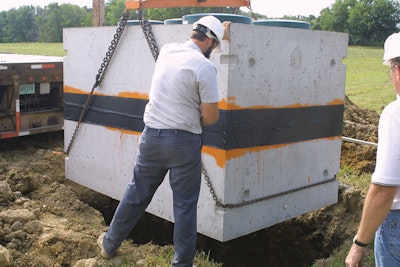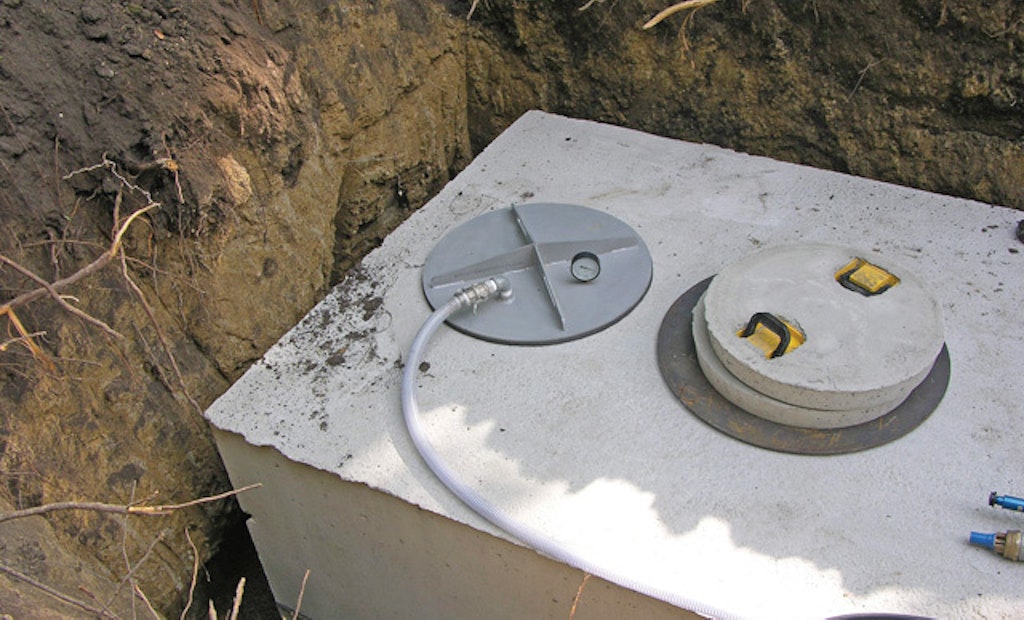Interested in Septic Tanks?
Get Septic Tanks articles, news and videos right in your inbox! Sign up now.
Septic Tanks + Get AlertsThis is the last in our series on installation of septic and sewage tanks. From here, we will move on to pump stations and pump controls as we work through system components. This month we look at backfilling tanks, tank access and watertightness.
Tanks should be backfilled with granular material to at least the midseam of tanks that have seams or halfway up the tank. From there, native soil materials can be used as long as they do not have rocks, pieces of concrete or other materials that can damage the tank. The backfill should be applied in lifts no more than 2 feet in depth and compacted.
If the tank bottom is rounded, then the compaction should take place in 6- to 12-inch lifts. As always, recognize that these are general guidelines — tank manufacturers may have specific requirements that must be followed.
Sealing the connections
Risers for the access holes in the tank for cleaning and maintenance should extend to the final finished grade. The ground should be sloped away from the covers to prevent surface water inflow. Access risers for concrete tanks are available in the whole spectrum of materials from concrete to polyethylene, polypropylene, and ribbed PVC tubing.
Polyethylene and polypropylene risers are typically connected to a precast tank with an adapter ring cast into the tank. These joints should be checked, and the installer should apply mastic as well to further seal the connections. Another option is to mechanically attach a flange to the tank top using butyl rubber and stainless bolts. The riser can be sealed with mastic and other adhesives.
Whatever the material, one of the largest issues to ensure that a tank remains watertight over its lifetime is how the connections are made. In dryer climates, watertight also means the joints are resistant to root penetration. In cold climates, good connections will stay in place even with the expansion and contraction involved with freezing temperatures.
Checking for leaks
Watertightness is critical to septic tank performance. If the tank is leaky, untreated sewage can be delivered into groundwater or bedrock. From an operation standpoint, water introduced to the system from surface water or inflow from groundwater can immediately overwhelm the soil treatment part of the system. Watertight means there should be no water entering or leaving the tank except through the piping.
When inspecting tanks before installation, verify that the concrete walls are watertight, without cracks. Check to see that the drainage hole at the bottom has been plugged, or be prepared to plug it as a part of your installation.
Tanks with mid-wall seams have a high probability of not being watertight. These seams should have some type of tongue-in-groove construction. The joints should also be sealed with mastic and wrapped with a type of tape that provides a mechanical connection at the joint to keep the joint from separating during installation and backfill.
Testing tanks
Tanks can be tested for watertightness before and during installation. This can be done by filling the tank with water (hydrostatic testing) or by vacuum testing. Methods for testing can be found in many practice manuals issued by universities and other educational organizations, and by tank manufacturers.
For vacuum testing concrete tanks, there is a standard procedure recognized by the National Precast Concrete Association. The advantage of vacuum testing is that it takes less time than hydrostatic testing.
All piping and risers should be installed in place at the time of the test. All openings are plugged, and a special insert is installed on one of the manholes. Using a pump, air is evacuated from the tank to a standard vacuum level.
The concrete tank standard is a vacuum of 4 inches of mercury for 5 minutes. Up to a 1/2 inch of mercury loss during the first period is allowed. Then the pressure is brought back to 4 inches and the vacuum must hold for 5 minutes with no pressure drop. Be careful not to exceed the recommended vacuum level — the tank could implode, which would of course ruin a good installation.
Water testing steps
When water testing plastic or fiberglass tanks, take care. The tank should be backfilled before the test to just below the midseam so the seam can be observed during the test. It is important for these tanks to be supported by soil as much as possible to maintain their strength.
Here are the basic steps for water testing:
1. Plug the inlet and outlet pipes with a watertight plug, pipe and cap or other seal. Seal the pipes away from the tank to test any pipe connections.
2. If testing a midseam tank, make sure the seam is exposed for the test.
3. Fill the tank to the top.
4. If there is a riser, add water into the riser at least 2 inches above the seam. Take care not to overfill, as the top section of a two-piece tank can become buoyant.
5. Measure and record the level of water.
6. Wait 24 hours. Any obvious leakage during this time should be evaluated and remedied by the application of the proper sealant.
7. If the test reveals leaks that cannot be repaired, the tank is unacceptable.
8. Refill concrete tanks to the original level after 24 hours, as they absorb some water.
9. Check again after 24 hours. If less than one gallon is lost in a concrete tank, the tank is considered acceptable.
In cold climates, if overnight temperatures will be below freezing during the test, cover and protect the opening to make sure the water does not freeze. Failure to do this can lead to erroneous readings, since the density of water at a very low temperature will result in a large drop in the water level. Even more important, if the water freezes, the expansion of the ice may crack the tank.
As always check with your state and local regulations to see what is required for watertightness testing.







